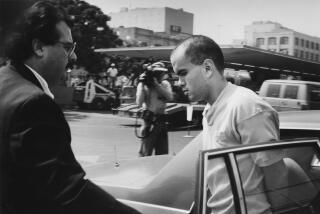Bizarre Lives Bared of Star, Son Accused of Her Murder
Timothy Scott Roman sat stoically in Van Nuys Superior Court last week while his attorney characterized him as “an experiment of the human race.”
Baby-faced, with soft eyes and a willowy frame, Roman looked like a lost child as court officials discussed his fate during a pretrial hearing.
Roman, who is unnaturally youthful-looking at 23, stands accused of the brutal murder of his mother, former actress Susan Cabot, 59, who was clubbed to death in her Encino home Dec. 10 with a weight-lifting bar.
Although he denied any involvement and blamed the bludgeoning on a Latino burglar wearing a Ninja warrior mask, prosecutors say they have strong circumstantial evidence pointing to Roman as the killer. His attorney is now planning a psychological defense.
Extensive court documents made available last week and an interview with the attorney Saturday revealed that, by focusing on Roman’s mother’s fragile mental condition, her unkempt home and her authorization of controversial drugs for her son, the defense intends to show that she may have contributed to her own death.
Defense attorney Chester Leo Smith argued in documents that Roman is an emotional wreck as a result of an overprotective, disturbed mother and a severe growth deficiency that has made him dependent on strong medications with dangerous side effects.
“Mr. Roman is probably, really, an experiment of the human race,” Smith said Wednesday at the courtroom hearing.
The case file, parts of which Smith unsuccessfully sought to have sealed last week, revealed that Roman and his mother lived in an exclusive hillside community in a home cluttered with debris. In court papers, Smith said the two lived in such “filth and chaos” that the conditions constituted child abuse.
The case could go to trial as early as this summer in the courtroom of Judge Richard G. Kolostian. Roman is being held without bail in County Jail.
The tale emerging about Roman’s life with his mother sounds like it was scripted in Hollywood, where Susan Cabot gained moderate fame in the 1950s as a leading actress in numerous “B” movies.
Born dwarfed, Roman would have grown to only about 4 feet tall, his attorney said, but, with the aid of steroids and other drugs to stimulate growth, Roman now is 5 feet, 4 inches and weighs about 135 pounds.
“They medically added more than a foot onto him,” Smith said. “When you force the size of an individual to increase, you also force brain cells to increase. What happens is that doctors are performing a balancing act.
“I think Roman is just a statistic that went bad.”
Besides the steroids he continues to take today, Roman was treated for 15 years with an experimental hormone that later was discontinued when it was linked to neurological disorders in some patients, the court records show. Smith said it may be years before doctors can determine whether Roman was damaged by the hormone.
Even the medications Roman now takes periodically cause behavioral changes, Smith asserted, saying he had noticed mood swings in his client. In fact, Roman has been concerned about his medications’ side effects and has taken it upon himself to try to regulate his dosages.
Fascinated with the martial arts and at one time a student of self defense, Roman has about a dozen posters of actor Bruce Lee on his bedroom walls, police photos of the crime scene show. Barbells and other weights lie on the floor.
Although Roman recently performed well in art and biochemistry courses at Pierce College in Woodland Hills, his high school math tutor recalled that, when Roman failed to take his medications, “he was virtually unable to add two-digit numbers,” according to records.
Portrait of Cabot
The defense supplements its picture of Roman with a bizarre portrait of Cabot, depicting her in a way that conjures up the Norma Desmond character in the 1950 film “Sunset Boulevard,” which starred Gloria Swanson in a story of a tormented, washed-up movie queen.
Once romantically linked to Jordan’s King Hussein, Cabot is portrayed in court records as an aging beauty whose short-lived acting career in low-budget films of the 1950s faded long before her death.
Cabot had an “adequate” income in recent years, Smith said, as a result of heady real estate transactions and her fascination with classic cars, which she had restored for resale.
She is said to have suffered recurrent mental breakdowns and to have withdrawn into a reclusive existence in her hilltop home, which was falling into disrepair. The interior, judging from court file photographs, belies its posh setting, with its panoramic view of the San Fernando Valley.
Smith, in court papers, said the mother and son had lived alone for several years in “massive filth and decay.” Photos show clothing, bags of garbage, stacks of newspapers and magazines and other items piled high and strewn about. Every room photographed shows a high degree of disarray.
The defense asserts that Cabot spoke with her therapist the day of the killing and told him she wanted to die. Cabot’s breakdowns, “hidden from the outside world,” exacerbated her son’s “emotional and developmental retardation,” Smith alleged in documents.
“The condition of the house would indicate that her instability had been developing over some period of time,” he said.
Hormone Problem Documented
Reams of medical records included in the court file chart Roman’s hormone problem, which required repeated hospitalizations during his youth.
A pediatrician in 1975 called Roman, who was then 11, “an emotionally immature, somewhat disturbed child who is having difficulty handling the demands of growing up.”
A psychologist in 1971 attributed some of Roman’s troubles to his mother’s theatrics.
“Much of the youngster’s immature behavior has been inappropriately reinforced by his mother,” the psychologist’s report stated, adding that Cabot, “being an actress, tends to be somewhat overly dramatic and overly concerned.”
Roman was among 10,000 patients treated with an experimental hormone in a nationwide program administered by the National Institutes of Health, records show.
He took the hormone from 1970 through 1985, when sales were discontinued because certain batches were found to be infected with a virus that causes Creutzfeldt-Jakob Disease. The disease can produce a degeneration of the central nervous system and has led to several deaths, according to medical articles that Smith submitted to the court file.
In court documents, Smith stated that parents whose children received the treatment knew of the risks but proceeded because “otherwise their children would be dwarfs.”
Citing the complicated medical records and the unusual defense strategy, Smith argued Wednesday that pretrial publicity could jeopardize his client’s right to a fair trial. His motion to seal parts of the file from public inspection was opposed by an attorney from The Times, and Kolostian ruled in the newspaper’s favor.
Prosecutor’s Plan
Deputy Dist. Atty. Bradford E. Stone said that, even if the defense proves that Cabot was eccentric and her son was emotionally underdeveloped--neither of which he concedes--the circumstances of the crime still amount to first-degree murder.
According to testimony at the preliminary hearing, Cabot was clubbed repeatedly on the head as she lay face down across her bed, dressed only in a purple nightgown.
Roman told police that he had gone to bed at 9:30 that night, but became hungry about 10 p.m. and went into the kitchen, detectives testified. There, he said, he encountered the “intruder,” who stabbed him in the arm and hit him on the forehead with a blunt object, knocking him unconscious.
He said he awoke 30 minutes later and telephoned police but never went into his mother’s room.
Stone said the strongest evidence was recovered from Roman’s own bedroom.
Although Roman permitted police to search the home, investigators were unable to enter his room for about six hours because they were intimidated by two Akita dogs, similar to large German shepherds, which Stone described as “ferocious.”
The first team of animal-control officers on the scene refused to remove the dogs, saying they were uncontrollable, Detective Joe Diglio testified. A second team succeeded with the aid of long poles equipped with lassos, he said.
Once inside, detectives found the alleged murder weapon--a weight-lifting bar--hidden in a box of “Bold 3” laundry detergent in a hamper. Matching muscle-building equipment was found on the floor, Stone said.
The prosecutor argued at the preliminary hearing that the dogs would not have permitted a stranger to enter Roman’s bedroom, retrieve the bar and return it to the same room. Only Roman, the dogs’ owner, could have done so without being attacked, he said.
In addition, Stone said, Roman suffered only a minor bump on his head and a quarter-inch cut on his arm.
“That’s hardly the degree of injury one would expect from a death-defying battle with a Ninja warrior,” he said.
Police said Roman and his mother had been feuding for some time, but they did not say over what. Anticipating a manslaughter defense, Stone dismissed the notion that Roman may have flown into a sudden, uncontrollable rage. Sudden rage is the defense commonly used by attorneys seeking the lesser charge.
“If he flamed out, how do you explain that the murder weapon got from his bedroom to hers, where she was beaten to death?” Stone said in an interview. “That takes some degree of thinking and planning.”
Cabot’s Career
Born Harriet Shapiro in Boston, Cabot made her film debut in 1950 in “On the Isle of Samoa.” She won starring roles in several other “B” movies, including “Fort Massacre,” “Ride Clear to Diablo,” “Duel at Silver Creek” and “Gunsmoke.”
She married Martin Eden Sacker in Washington in 1944, but they separated in 1951. Years later, she wed businessman and former actor Michael Roman, the defendant’s father, who moved to New Orleans after their divorce several years ago. Attempts to contact him were unsuccessful.
Since the killing, Roman has been in “constant” contact with his father, who has been supportive and intends to testify on his behalf at the trial, Smith said.
The Roman family had lived in the neighborhood about 11 years. The white-brick home, framed by pine and palm trees, is now eerily quiet. Only police and attorneys have entered it since the killing, Smith said.
White Christmas lights still hang from the front gate, and a small dying evergreen adorned with holiday bulbs is visible through the front window. Withered plants sit in pots on the veranda.
Neighbors said they knew little about the family. “You never really heard anything out of that house,” one said.
Another, observing that Cabot and her son kept mostly to themselves, said, “She never went any place without him. He was very dependent on her.”
A third described Cabot as a “pleasant person” but added, “She was . . . different.”
Also contributing to this story were Times staff writers Patricia Klein and Tracey Kaplan.
More to Read
Sign up for Essential California
The most important California stories and recommendations in your inbox every morning.
You may occasionally receive promotional content from the Los Angeles Times.










